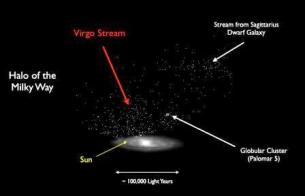
Mapping the Milky Way Halo
The halo of the Milky Way Galaxy is the roughly spherical region extending to more than 300,000 light-years from the Galactic Center. The halo was once thought to consist of ~ 80 globular clusters and a low density of very old stars that declined smoothly with distance from the Galactic Center. Recent surveys have revealed, however, a wealth of substructure that is probably debris from dwarf galaxies that have been torn apart by the tides produced by the gravitational force of the Milky Way.
|
08.08.2011 The Fate of the First Black Hole Now astronomers Krzysztof Belczynski and Tomasz Bulik of the University of Warsaw and Charles Bailyn of Yale University have used the precise new parameters for Cygnus X-1 to predict its fate. MORE INFO |
 |
|
07.26.2011 Asteroid named in honor of Michele Dufault (1988-2011) Asteroid (15338) Dufault = 1994 AZ4 is official, published in the 2011 July 15 batch of Minor Planet Circulars. It appears as follows on MPC 75548: (15338) Dufault = 1994 AZ4 Discovered 1994 Jan. 5 by Spacewatch at Kitt Peak. MORE INFO |
 |
Colloquia & Seminars | VIEW ALL
|
 |
|
 |
|
 |
|
 |
Public Events | VIEW ALL
The Leitner Family Observatory and Planetarium is open every Tuesday night for a planetarium show. Weather permitting there will also be public viewing of planets, nebulae, star clusters and whatever happens to be interesting in the sky. Seats are available on a first come first serve basis. No reservations necessary.
Current updates are posted under the Newsblog and Calendar sections at leitnerobservatory.org

















